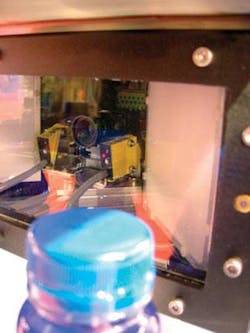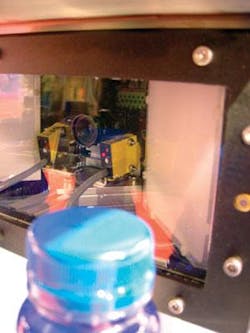Machine vision checks bottle-cap seals
To meet supplier demands, manufacturers of bottled products must fill, cap, and seal products rapidly using high-speed systems. Then each of these products must be checked to determine whether the bottle has been filled to an acceptable level and whether the cap is correctly placed and positioned.
“Today,” says Steve Belling, product manager with Silgan Equipment Company (Downers Grove, IL, USA; www.silganequipmentcompany.com), “these manufacturers are also incorporating added levels of protection in the form of tamper bands that are wrapped around the cap. With tamper bands in place at the base of the closure, consumers are assured that the product has not been altered. Furthermore, such sealing also guarantees the quality and freshness of the bottled product.”
While such packaging techniques may provide the consumer with an added level of security, they present the system integrator tasked with high-speed inspection an extra level of complexity. Not only must the automated inspection system check for correct fill level and proper cap placement, it must also inspect the integrity of the tamper band. At this year’s Pack Expo (Las Vegas, NV, USA), Silgan Equipment presented its latest bottle-inspection system capable of performing all three tasks at speeds of up to 1200 bottles/min (see figure).
Conveyor-based, the Silgan system uses an embedded host PC and a PLC to control all the functions of the machine, including the conveyor speed, lighting control, camera interface, triggering mechanisms, and rejection mechanisms. In operation, bottles to be inspected move along the conveyor where they are illuminated by a 2.5-in.-square white flat-panel LED. After their presence is detected by a photoelectric detector from Banner Engineering (Minneapolis, MN, USA; www.bannerengineering.com), three RGB FireWire cameras from Point Grey Research (Vancouver, BC, Canada; www.ptgrey.com) digitize three images of the top of the container. “By placing these cameras 180° apart,” says Belling, “each camera can capture at least a 120° view of the container. In this way, a complete 360° inspection can be accomplished.”
After the images are captured and transferred to the host PC, they are processed by software running on the host PC. Rather than use off-the shelf software, Silgan contracted Manufacturing Control Solutions (MCS; Glen Ellyn, IL, USA; mcsvision.com) to develop the software application, based on MCS C++ image-processing library and Visual C++ user interface. “As bottles pass through the inspection station,” says Belling, “the height, width, gap size, and horizontal position of the tamper band must be measured and compared with programmable limits.”
A known region of interest (ROI) within the image is determined and edge detection performed to find the middle of the cap and the middle of the neck of the bottle. “Since the tamper band should be located between the middle of the cap and the middle of the neck,” says Belling, “any missing band will make this region appear brighter, since light will not be obstructed by a tamper band.” In this way, the system can detect the presence or absence of the tamper band.
Fill-level inspection is performed similarly. Should a bottle be incorrectly filled, the intensity of light passing though the bottle will appear lower than if the bottle is correctly filled, since the contents will attenuate light.
To inspect for the correct position and color of each cap, the software measures the distance of the lefthand side, righthand side, and middle distance between the neck of the bottle and each cap. “In this way,” says Belling, “the software can determine whether the cap is correctly placed. By measuring the color in a specific ROI within the cap, the color consistency of each cap can also be checked.”
After each of these parameters is stored in host-PC memory, a networked encoder module under control of a Series 1200 PLC from Micrologix/Allen-Bradley (Milwaukee, WI, USA; www.ab.com) tracks the bottle position for potential rejection. Should any bottle fail some or all of the inspection, the PC triggers the PLC to reject the bottle using a pneumatic actuator. Says Belling, “The system also stores the information about each inspection in a Microsoft-compatible database, allowing quality-assurance information to be written to a spreadsheet for later retrieval.”

